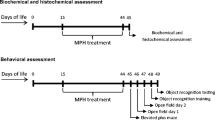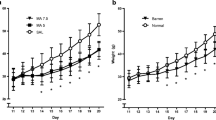Abstract
Neonatal rats treated at 7 days of age with 6-hydroxydopamine show normal levels of activity during maturation, but less hyperactivity than normals do when additionally treated with methylphenidate hydrochloride between 14 and 22 days of age. Comparison of these results with those of other workers suggests that several experimental variables must be controlled precisely if reproducible results analogous to the disturbed behaviour of children with minimal brain dysfunction (MBD) are to be obtained.
Similar content being viewed by others
References
Breese, G. R., Cooper, B. R., Hollister, A. S.: Involvement of brain monoamines in the stimulant and paradoxical inhibitory effects of methylphenidate. Psychopharmacologia (Berl.) 44, 5–10 (1975)
Breese, G. R., Traylor, T. D.: Depletion of brain noradrenaline and dopamine by 6-hydroxydopamine. Br. J. Pharmacol. 42, 88–99 (1971)
Breese, G. R., Traylor, T. D.: Developmental characteristics of brain catecholamines and tyrosine hydroxylase in the rat: effects of 6-hydroxydopamine. Br. J. Pharmacol. 44, 210–222 (1972)
Conners, C. K., Eisenberg, L.: The effects of methylphenidate on symptomatology and learning in disturbed children. Am. J. Psychiatry 120, 458–464 (1963)
Costall, B., Naylor, R. J.: The involvement of dopaminergic systems with the stereotyped behaviour patterns induced by methylphenidate. J. Pharm. Pharmacol. 26, 30–33 (1974)
Greese, I., Iversen, S. D.: Blockage of amphetamine induced motor stimulation and stereotypy in the adult rat following neonatal treatment with 6-hydroxydopamine. Brain Res. 55, 369–382 (1973)
Davis, J. D., Ellison, G. D.: A general purpose activity recorder with variable sensitivity. J. Exp. Anal. Behav. 7, 117–118 (1964)
Fibiger, H. C., Fibiger, H. P., Zis, A. P.: Attenuation of amphetamine-induced motor stimulation and stereotypy of 6-hydroxydopamine in the rat. Br. J. Pharmacol. 47, 683–692 (1973)
Glowinski, J.: Effects of amphetamine on various aspects of catecholamine metabolism in the central nervous system of the rat. In: Amphetamines and related compounds. E. Costa and S. Garattini, eds., pp. 301–316. New York: Raven 1970
Hollister, A. S., Breese, G. R., Cooper, B. R.: Comparison of tyrosine hydroxylase and dopamine-β-hydroxylase inhibition with the effects of various 6-hydroxydopamine treatments of d-amphetamine induced motor activity. Psychopharmacologia (Berl.) 36, 1–16 (1974)
Knights, R. M., Hinton, G. G.: The effects of methylphenidate (Ritalin) on the motor skills and behaviour of children with learning problems. J. Nerv. Ment. Dis. 148, 643–653 (1969)
Moore, K. E., Carr, L. A., Dominie, J. A.: Functional significance of amphetamine-induced release of brain catecholamines to behaviour. In: Amphetamines and related compounds, E. Costa and S. Garattini, eds., pp. 371–384 New York: Raven 1970
Rech, R. H., Stolk, J. M.: Amphetamine-drug interactions that relate brain catecholamines to behaviour. In: Amphetamines and related compounds. E. Costa and S. Garattini, eds., pp. 385–414. New York: Raven 1970
Schanberg, S. M., Schildkraut, J. J., Kopin, I. J.: The effects of pentobarbital on the fate of intracisternally administered norepinephrine-H3. J. Pharm. Exp. Ther. 157, 311–318 (1967)
Scheel-Krüger, J.: Comparative studies of various amphetamine analogues demonstrating different interactions with the metabolism of the catecholamines in the brain. Eur. J. Pharmacol. 14, 47–59 (1971)
Shaywitz, B. A., Klopper, J. H., Yager, R. D., Gordon, J. W.: Paradoxical response to amphetamine in developing rats treated with 6-hydroxydopamine. Nature 261, 153–155 (1976b)
Shaywitz, B. A., Yager, R. D., Klopper, J. H.: Selective brain dopamine depletion in developing rats: An experimental model of minimal brain dysfunction. Science 191, 305–308 (1976a)
Thornburg, J. E., Moore, K. E.: The relative importance of dopaminergic and noradrenergic neuronal systems for the stimulation of locomotor activity induced by amphetamine and other drugs. Neuropharmacology, 12, 853–866 (1973)
Wender, P. H.: Minimal brain dysfunction in children. New York: Wiley-Interscience 1971
Winer, B. J.: Statistical principles in experimental design. 2nd ed., Ch. 6. New York: McGraw-Hill 1971
Author information
Authors and Affiliations
Rights and permissions
About this article
Cite this article
Eastgate, S.M., Wright, J.J. & Werry, J.S. Behavioural effects of methylphenidate in 6-hydroxydopamine-treated neonatal rats. Psychopharmacology 58, 157–159 (1978). https://doi.org/10.1007/BF00426899
Received:
Issue Date:
DOI: https://doi.org/10.1007/BF00426899




